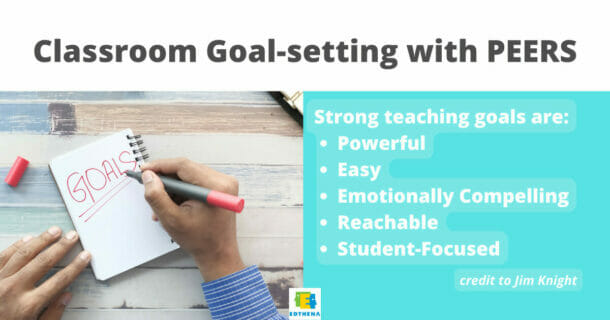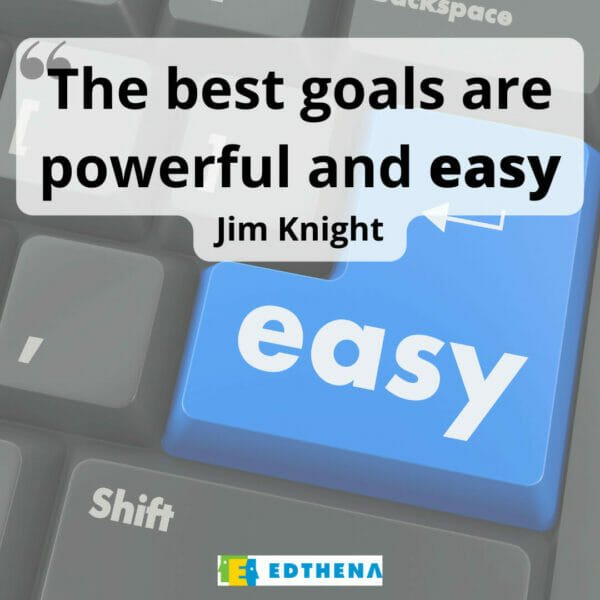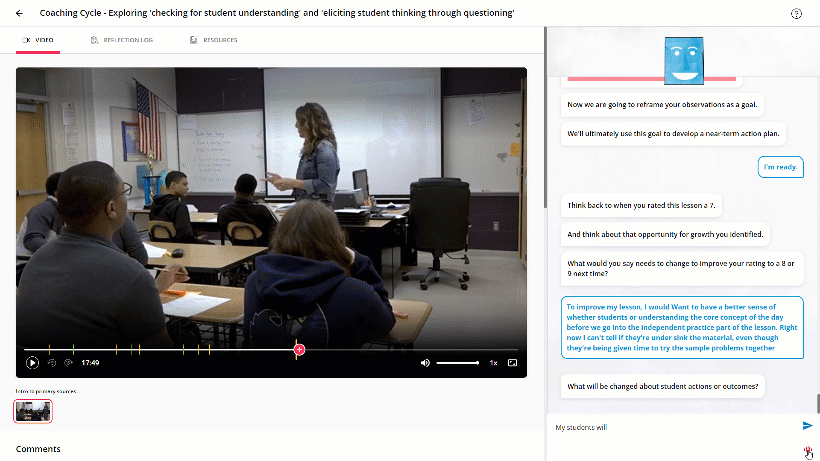Teacher Goal-Setting Should Be Meaningful: How to Help Educators Set More Powerful Goals

Teachers, and the instructional coaches who support them, frequently set goals aimed at improving teacher practice and student outcomes.
There are many frameworks used to help form and evaluate teacher goal-setting. SMART goals help teachers and school leaders define goals that are Specific, Measurable, Attainable, Realistic, and Timely. SMART goals are focused on being trackable and attainable within a certain time frame.
But if those teacher goals aren’t meaningful, will accomplishing them lead to true, effective change? Or will they be even accomplished at all?
PEERS goals (Powerful, Easy, Emotionally Compelling, Reachable, and Student-Focused), developed by Jim Knight, are a tool for creating and better understanding goals for meaningful outcomes.
Through a series of prompts and questions, the PEERS goals framework helps teachers reflect on and determine high-quality goals for improvement and professional learning.
That’s the aim we have for the Edthena AI Coach platform, too. AI Coach by Edthena coaches teachers to self-reflect. Teachers analyze their own classroom videos and work through a coaching cycle aligned to their self-identified growth areas by having a structured conversation with a virtual coach.
Throughout the conversation, Edie, the virtual coach, prompts teachers with reflection questions and teacher goal-setting guidance.
Keep reading for our breakdown of the questions the PEERS goal framework uses to drive insight and intention within teacher goal-setting and how this experience is embodied by the AI Coach platform.
Powerful: Will this goal make a real difference?
The P in PEERS goals stands for Powerful.
In Jim Knight’s instructional coaching model, teachers are guided to develop a strong goal by evaluating if their goal will make an important difference for students.
What’s the point of a goal if it won’t make a meaningful change?
During the Reflect phase of the AI Coach coaching cycle, the virtual coach supports teachers to develop a near-term goal in their professional growth priority area after analyzing their own teaching video.
By reflecting on the patterns they see, teachers determine an area of need or growth based on what they’re actually seeing instead of relying on what they feel to be true.
This use of evidence leads to powerful goals—teachers can clearly see what change is needed to impact their practice and students. Using actual video to decide what to work on shows teachers how their actions will make a difference.
Easy: Can I implement this goal?
The first E in PEERS goals stands for Easy.
A powerful goal won’t mean much if it’s never implemented. Teachers must know that the goal they set is that it is something they can do. 
Jim Knight wrote, “The best goals are goals that are powerful and easy, because they have the greatest likelihood of being implemented, and because they provide more time for teachers, who are very busy, to work on other important tasks.”
Inside the AI Coach platform, teachers determine their big picture goal area as well a bite-sized next step action. This helps teachers go from a big idea for change to something that’s easy to take the next step on.
When teachers set short-term milestones, it makes a goal more implementable.
Emotionally compelling: Does this goal move me emotionally to action?
The second E in PEERS goals stands for Emotionally Compelling.
“Effective goals need to be more than SMART; they need to compel people to action by moving them emotionally,” Jim Knight notes.
Strong teacher goal-setting should include a built-in element of compelling educators to action. Without an emotional connection to their goal, teachers might have a path ahead but not the intrinsic motivation needed to push forward.
Edie, the virtual coach, doesn’t leave this to chance. Edie asks teachers explicitly why their set goal matters to them.
Teachers are empowered with their reason and motivation for change by building this connection to their goal.
Reachable: Does this goal build hope?
The R in PEERS goals stands for Reachable.
“A reachable goal is one that builds hope,” according to Jim Knight.
Even when a goal is easy, teachers must believe they have the agency to plan for how they will make their goal happen and accomplish the goal.
Here’s what Jim Knight’s Instructional Coaching Group writes about PEERS goals being reachable:
“A goal that fosters hope is a goal that has a reasonable chance of being achieved because (a) teachers believe they can achieve it (agency) and (b) it includes a strategy or strategies that can help them achieve it (pathways).”
Edie the virtual coach acts as a guide-on-the-side as teachers plan how they will make their goal feasible. The virtual coach helps in two key ways.
First, Edie guides teachers to create a timeline during which they will implement these changes related to the goal. Teachers building the plan themselves is key to having agency and believing the goal is reachable.
Second, Edie also asks teachers how they will measure the impact of their changes in teaching practice.
“As SMART goals have shown for years, the goal has to be measurable; it has to have a finish line,” Jim Knight acknowledged.
With a clear plan for how they will make and measure changes, teachers have a path forward for reaching where they want to go.
Student-focused: Is this goal student-focused rather than teacher-focused?

Finally, the S in PEERS goals stands for Student-Focused.
The strongest teacher goals may require a change in teacher action but must ultimately be connected to making a change for students.
For example, Jim Knight cites a goal such as using graphic organizers at least twice a week.
Teachers need to evaluate how their goal will make a difference for students.
This not only “provides clear feedback on whether or not changes make a difference for students,” it ultimately is a reminder that classroom teacher goal-setting is about student learning.
In the AI Coach platform, Edie the virtual coach anchors the teacher’s thinking to their students by asking the teacher to describe what will be changed with students if they achieve their stated goal.
When teachers keep a student focus in mind, they create a stronger goal that goes beyond their own actions.
Goals are more likely to be accomplished when PEERS goals guide teacher goal-setting
Teacher goal-setting can feel frustrating when a goal is not well-crafted and doesn’t lead to teacher action and impact.
The framework laid out with the PEER goals provides a way to ensure classroom and teaching goals are Powerful, Easy, Emotionally Compelling, Reachable, and Student-Focused.
Want to learn more about how the AI Coach by Edthena helps teachers? Read this blog post about how the AI Coach platform supports stronger teacher collaboration.
Want to try out the AI Coach platform? Sign up for AI Coach access here.
